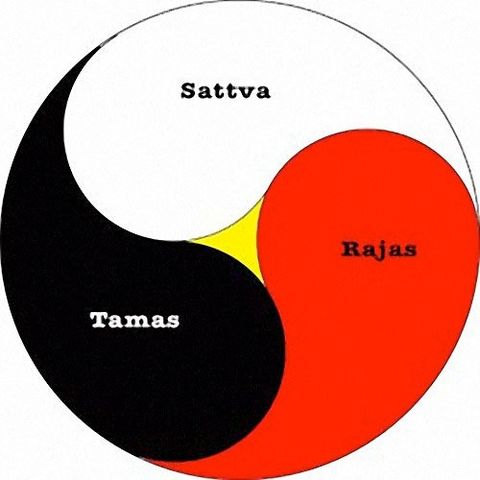
The three attributes of the five aura electricities.
"The five electricities, Pancha Tattwa, from their three attributes, Gunas - Sattwa (positive), Rajas (neutralizing), and Tamas (negative) - produce Jnanandriyas (organs of sense), Karmendriyas (organs of action), and Tanmatras (objects of sense)." (Swami Sri Yukteswar, The Holy Science, Sutra 7-10)
Guna (Sanskrit: ???) is a concept in Hinduism, which can be translated as "quality, peculiarity, attribute, property".
The concept is originally notable as a feature of Samkhya philosophy. The gu?as are now a key concept in nearly all schools of Hindu philosophy. There are three gu?as (trigu?a), according to this worldview, that have always been and continue to be present in all things and beings in the world. These three gu?as are called: sattva corresponds to harmony, freedom, bliss and perception; rajas - activity, passion and energy, and tamas - inertia, passivity, will and stability. All of these three gu?as are present in everyone and everything, it is the proportion that is different, according to Hindu worldview. The interplay of these gu?as defines the character of someone or something, of nature and determines the progress of life.
In some contexts, it may mean "a subdivision, species, kind, quality", or an operational principle or tendency of something or someone. In human behavior studies, Guna means personality, innate nature and psychological attributes of an individual.
Like all Sanskrit technical terms, gu?a can be difficult to summarize in a single word. Its original and common meaning is a thread, implying the original materials that weave together to make up reality. The usual, but approximate translation in common usage is "a quality".
Guna means attribute, quality, strand. This word has many connotations, but the most common usage belongs to the vocabulary of the yoga and Samkhya traditions, where it refers to the well-known triad of forces—sattva, rajas, and tamas—that are thought to be the fundamental qualities of prakriti (Nature). These qualities are considered the primary dynamic forces of Nature, as they represent the principles of activity and dynamism (rajas), inertia (tamas), and harmony (sattva). Their combined interaction creates the entire manifest world. They underlie all material as well as psycho-mental phenomena.
Sattva is regarded as buoyant and illuminating. Its corresponding color is white. Rajas is stimulating and mobile. Its corresponding color is red. Tamas is inert and concealing. Its corresponding color is black. As qualities of Nature, they all (even sattva guna) essentially represent a limiting aspect, as the Bhagavad Gita (14:6-8) affirms: “Sattva binds through attachment toward knowledge and happiness; rajas binds the incarnated spirit though attachment toward action, and tamas binds through negligence, indolence and sleep.”
See Also
7.8 - Matter and Spirit are Opposite Poles
8.26 - Law of Force
Entropy
Intelligence
Law of Force
Mind
Negative
Neutral
Pancha Tattwa
Sense
Syntropy
